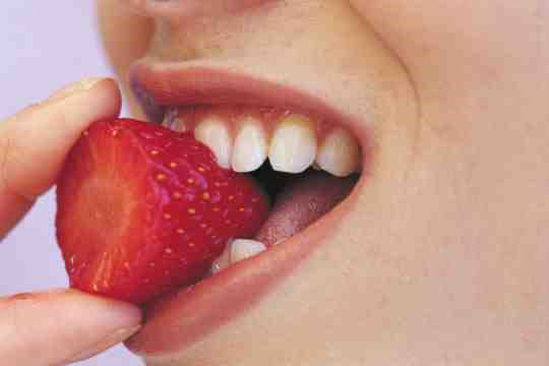
I have made it a rule to give every tooth of mine a chance, and when I eat, to chew every bite thirty-two times. To this rule I owe much of my success in life. -William Gladstone
ChewingWhen it comes to increased health, it’s not just what we eat but how we eat. Digestion actually begins in the mouth, where contact with our teeth and digestive enzymes in our saliva break down food. But these days most of us rush through the whole eating experience, barely acknowledging what we’re putting in our mouths. We eat while distracted—working, reading, talking and watching television—and swallow our food practically whole. On average we chew each bite only eight times. It’s no wonder that many people have digestive problems.
There are many great reasons to slow down and chew your food.
Saliva breaks down food into simple sugars, creating a sweet taste. The more we chew, the sweeter our food becomes, so we don’t crave those after-meal sweets.
Chewing reduces digestive distress and improves assimilation, allowing our bodies to absorb maximum nutrition from each bite of food.
More chewing produces more endorphins, the brain chemicals responsible for creating good feelings.
It’s also helpful for weight loss, because when we are chewing well, we are more apt to notice when we are full.
In fact, chewing can promote increased circulation, enhanced immunity, increased energy and endurance, as well as improve skin health and stabilize weight.
Taking time with a meal, beginning with chewing, allows for enjoyment of the whole experience of eating: the smells, flavors and textures. It helps us to give thanks, to show appreciation for the abundance in our lives and to develop patience and self-control.
The power of chewing is so great that there are stories of concentration camp survivors who, when others could not, made it through with very little food by chewing their meager rations up to 300 times per bite of food. For most of us 300 chews is a daunting and unrealistic goal. However, you can experience the benefits of chewing by increasing to 30 chews per bite. Try it and see how you feel.
Try eating without the TV, computer, Blackberry, newspaper or noisy company. Instead just pay attention to the food and to how you are breathing and chewing.
This kind of quiet can be disconcerting at first, since we are used to a steady stream of advertising, news, media, email and demands from others. But as you create a new habit, you will begin to appreciate eating without rushing. You have to eat every day—why not learn to savor and enjoy it?
quinoaFood Focus: Quinoa
Quinoa (pronounced keen-wah), is a nutritional powerhouse with ancient origins. It was originally cultivated by the Incas more than 5,000 years ago; they referred to it as the “mother of all grains.” It contains all nine essential amino acids, making it a great source of protein for vegetarians. Quinoa is also high in magnesium, fiber, calcium, phosphorus, iron, copper, manganese, riboflavin and zinc.
While quinoa is widely considered a grain, it’s actually the seed of a plant called Chenopodium or Goosefoot, related to chard and spinach. Quinoa is a gluten-free grain and has a similar effect as other whole grains in helping to stabilize blood sugar.
It has a waxy protective coating called saponin which can leave a bitter taste. For best results, rinse quinoa before you cook it or even soak it for a few hours or overnight. When cooked, it has a fluffy, slightly crunchy texture. Try it in soups, salads, as a breakfast porridge or as its own side dish.
For quinoa, and whole grains in general, the majority of digestion occurs in the mouth through chewing and exposure to saliva. For optimal nutrition and assimilation, it is vital to chew your grains well and with awareness. A great meditation is to find a calm place, without distractions, to sit down for your meal. Make it a habit to chew each bite 20 times or more. See how this simple practice can help your digestion and overall focus for the rest of your day.
Recipe of the Month: Quinoa Pilaf
Prep Time: 3 minutes
Cooking Time: 30-40 minutes
Yield: 4 servings
Ingredients:
1 cup quinoa
2 1/4 cups water or stock
1/2 cup dried cranberries
1/2 cup walnut pieces
1/4 cup chopped fresh parsley
pinch of salt
Directions:
1. Rinse quinoa in fine mesh strainer until water runs clear.
2. Boil the water and add quinoa and salt, cover and reduce heat.
3. After 15 minutes add cranberries and walnuts to top; do not stir.
4. Cook 5 minutes more, until all the liquid is absorbed.
5. Remove from heat, add parsley and fluff with fork, cover and let sit for 3-5 minutes and serve.
Have a Wonderful Healthy Day!
Julie

POST REPLY